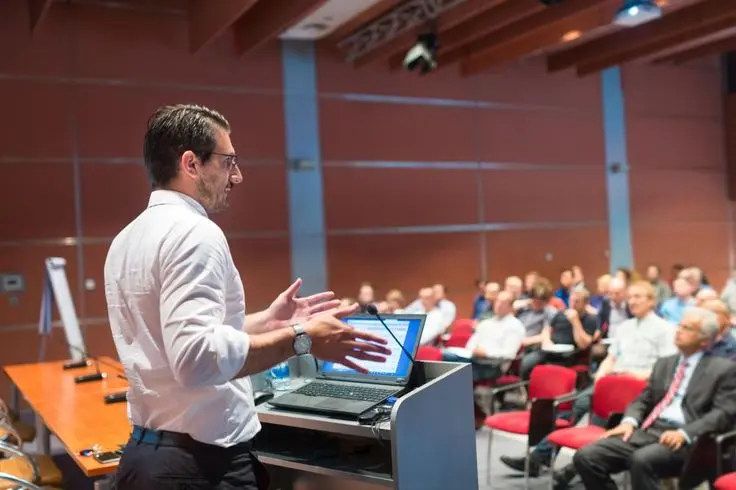The Q&A (Questions and Answers) session is one of the biggest fears that even the most seasoned public speakers face—and understandably so, since Q&A sessions are often highly unpredictable. What public speakers fear most is the lack of control, whether it’s over the types of questions that will be asked or the reactions their answers will elicit.
Unlike the prepared portion of a presentation, the Q&A session places control in the hands of the audience. It opens the speaker up to criticism. As a public speaker, you are bound to face confrontational listeners. Some may even be downright intimidating, and these individuals can be tricky to deal with if you aren’t a confident public speaker.

Q&A Sessions
Q&A sessions are crucial to your speech as they allow for direct engagement between you and your audience. Unlike the rest of your speech, which is usually a one-way communication channel, the Q&A session provides a platform for listeners to exchange ideas with the speaker. This exchange not only fosters a sense of inclusion but also ensures that the audience feels heard and valued.
Some people might want to share their perspectives or challenge the points in your speech. Hosting a Q&A session opens them up to do this. More importantly, the session provides you with an opportunity to address concerns and clarify key points that may not have been explained well enough in your speech. From the speaker’s perspective, Q&A sessions are also a valuable source of feedback. They highlight areas where the audience may need more clarity or show the topics that generate the most interest, guiding you in making future improvements. The questions posed can reveal gaps in your presentation, suggest new angles for exploration, or in the best case scenario, confirm the effectiveness of your content.

Preparing for a Q&A Session
As a speaker, it might be impossible to predict every question asked during a Q&A, but you can anticipate the kinds of questions that might come up. Instead of entering the session blindly, try researching your audience’s demographics, such as their profession and education level, to help predict the questions they might ask. If this data isn’t available to you, consider analyzing your speech script and identifying parts that are most likely to spark a debate.

Formulating ResponsesDuring your preparation, formulating answers beforehand is just as important as anticipating questions. To streamline your preparation, try categorizing anticipated questions into three main groups: Clarification, Challenge, and Curiosity. Each type requires a distinct approach when crafting your responses. How you word your answers will need to be adjusted depending on the type of question asked.
- Clarification
Clarification questions are typically asked by listeners seeking elaboration on points they find hard to grasp.
Solution: For these questions, use simple and illustrative language to break down complex ideas into more accessible terms.
- Challenge
Challenge questions are often asked by audience members who seek justification for accepting your ideas. These questions may sound skeptical, but they present an opportunity for you to reinforce your arguments.
Solution: Respond with a calm and confident tone, and back your points with evidence, examples, or data that you have prepared beforehand. The key is to avoid becoming defensive, as this can undermine your credibility. - Curiosity
Curiosity questions arise from genuine interest and signal that the audience wants to learn more about your topic. These questions can be considered compliments, and you should use this opportunity.
Solution: engage with your audience by providing more insights, anecdotes, or resources.
By tailoring your responses to the nature of each question, you can handle Q&A sessions with ease. If you encounter a question completely outside your area of expertise, instead of providing a speculative or inaccurate response, acknowledge your limits and commit to following up later. The key is that, with preparation, you can stay composed throughout the entire session. A well prepared visual aids can also help you be better prepared during presentation, you can learn more about preparing visual aids for public speaking here.

Practice Active Listening
During a Q&A session, it’s best to fully listen to a question before responding. Many novice public speakers fall into the trap of formulating an answer before the question is complete. This shortcut can lead to irrelevant or incomplete responses.
Active listening not only ensures that you answer appropriately but also demonstrates respect for the audience. When a question is asked, focus on listening and avoid interrupting or making assumptions.
If needed, repeat the question aloud to confirm your understanding and ensure the entire audience hears it. Repeating the question also gives you a moment to organize your thoughts and formulate a clear answer.
Encourage Your Audience
Sometimes, audiences hesitate to ask questions for various reasons, such as shyness or uncertainty about whether their questions are appropriate. As a professional public speaker, it’s your responsibility to break down this barrier by prompting your audience to engage. These prompts signal your openness to dialogue and inspire more thoughtful and specific questions.
Seek Guidance
If you’re still struggling to handle Q&A sessions like a pro after trying these tips, consider signing up for a public speaking course here with us at MicFront Academy.
MicFront Academy is ideal for those looking for the right guidance and training to become professional public speakers. The personalized approach by the coaches at MicFront Academy are designed to help students address their public speaking fears, especially during tricky Q&A interactions.
Through hands-on experience in managing diverse audiences, students gain the ability to maintain composure under pressure. In addition to mastering the technical aspects of public speaking, MicFront Academy focuses on building students’ overall confidence and stage presence. You can also read our other public speaking tips here.
Conclusion
With the right method of preparation, you will handle a Q&A session like a breeze.
Confidence, like any skill, can be built through practice and preparation — sometimes it takes weeks or months, depending on whether you’re receiving the right guidance.
In a nutshell, anticipate questions, formulate answers, & practicing active listening. We are sure you can navigate Q&A sessions with ease through practice with these general principles.
Consider MicFront Academy for coaching and let us help you shine in the arena of public speaking.